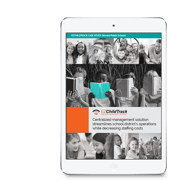
When you care for children, a safe environment is critical. No childcare professional wants to tell a parent a little one has been injured or become ill because of something at the facility. Improving safety in your daycare is an ongoing activity that reassures parents you are taking your responsibility seriously and is high on a family’s list of “must-haves” for an appropriate care situation.
Below are improvements and safety practices that should be performed at every childcare facility no matter the size.
Licensing
Prominently display your license and certifications to show that you comply with the state’s standards of care and that you are committed to continuing education and training for you and your staff. Part of the licensing process is demonstrating you maintain a safe, clean facility and have agreed to undergo periodic inspection and observation by a third party.
Certifications that clearly demonstrate your commitment to childcare education and welfare include those from:
- National Association of Education of Young Children
- National Association of Family Child Care
- National AfterSchool Association
Both certifications indicate your knowledge, experience, and study of early childhood development.
Policies
Written policies for safety, security, and health protect you, the children, and the parents. Written policies should be developed and provided to everyone with a relationship to the facility, particularly staff and parents.
Besides placing copies in registration and enrollment packets, consider making the policies available online through a parent portal or upon request through a form on your website. Be sure to respond promptly to any request for documentation; it may be a prospective client, or it could indicate the interest of an auditor.
As public review sites proliferate, the ability to obtain clearly written documents quickly may be an important part of a site’s review process or a checkpoint prospective parents look for when shopping for childcare.
Examples of policies you should develop and make available include:
- Child pickup screening
- Sick child procedures
- Disciplinary practices
- Infection control and sanitation processes
For transparency (another watchword for today’s clientele) create an open-door policy that makes parents feel welcome to observe classrooms and other areas of the facility both before and after enrollment. Be ready to answer any questions and elicit responses about what the visitors observe to help you improve your policies.
Staffing
Background checks are becoming a fact of life in many industries. Your clients rightly demand a safe environment for their children and performing a background check before hiring new staff is a given.
Aside from hiring safe and highly educated staff, you also want to demonstrate a consistent environment with low turnover. Children need and want to form connections with their caregivers and teachers; a high turnover rate makes that impossible. Over time, losing and hiring new staff on a continuous basis is harmful to childhood development.
Retention also shows that the teachers are happy to be there and are more apt to treat the children well.
Maintain the recommended staff-to-child ratio for each age group in your facility.
- One adult per four infants aged birth to eighteen months
- One adult per four young toddlers eighteen months to two years
- One adult per six older toddlers two to three years
- One adult per nine preschoolers older than three years
At least one member of your staff on duty each day, but preferably all staff, should receive training and continuing education in pediatric CPR and first aid. With small children come every size accident you can imagine; it is only prudent to be prepared for anything from a scraped knee to a choking incident.
Obtain and display certificates of completion to show parents and inspectors that your staff is ready for any emergency.
Childproofing
Childproofing a childcare facility should be a no-brainer, but some tips and reminders of areas of concern are always helpful.
Indoors you want to ensure each of these potential hazards are eliminated:
- Loop window blind cords out of reach and fasten them with anchors
- Place cribs out of reach of windows and blinds
- Cover all unused electrical outlets
- Block stairs and doorways with gates
- Retain straps on changing tables and high chairs
- Secure all medications and cleaning supplies in a locked cabinet out of reach of children
If you maintain an outdoor area for play, you can ensure safety with:
- Appropriate size equipment for each age group
- A soft and resilient surface to cushion falls that extends at least six feet beyond the playground equipment on all sides
- Surfaces covered with sand, pea gravel, wood chips or mulch, or one of the soft playground surfaces that are now available (no dirt or grass)
- A border area with fence or another barrier to keep children within the safe area
Teach all the children to use all the equipment appropriately and to stay away from moving swings. Also, teach them to watch for others while riding moving toys and to wait for the group before crossing a street or parking lot.
When you purchase or receive toys and equipment always check them before allowing the children to use them.
- Clean
- Good condition
- No recalls
- No choking hazards
- Nothing sharp or breakable
Anchor all shelves and cabinets to the walls and cover sharp corners on furniture.
Cleaning and Sanitizing
Cleaning and sanitizing are two separate steps to be performed in sequence.
- Thoroughly wash toys, surfaces, and potty chairs or covers with soap and water. Rinse thoroughly.
- Sanitize (disinfect) with bleach and water solution.
Durable toys and other items can be placed in the dishwasher where high-pressure sprays and temperatures take care of most dirt and bacteria. Sanitize with bleach and water solution once they are clean.
For laundering cloth toys, linens, and bedding, add 1/2 cup chlorine bleach for colorfast items or non-chlorine bleach for non-colorfast items. Always use cleaning supplies according to the manufacturer’s label.
Use extra care with commercial disinfectants; many are not suitable for children. Anything marked as hospital grade is not acceptable. For anything else, check with your childcare nurse consultant or your licensing agency for acceptable solutions.
Handwashing
Washing hands thoroughly and often will do the most to stop the spread of illness throughout the facility. Teach the children to wash their hands before eating and after toileting. Every staff member should wash their hands before preparing food, after diapering or assisting with toileting.
Bathroom Safety
Maintain supervision of children and infants at all times within bathroom and diaper changing areas. Never leave a toddler alone in the bathroom and always remain with an infant on the changing table throughout the diaper change. Before beginning, ensure all supplies are within reach and provide disposable latex gloves for staff.
Never leave a container of water anywhere to protect against accidental drownings; toddlers are especially prone to accidents around open toilet bowls or buckets of water.
As a responsible childcare provider, you should be committed to providing a safe and secure environment for your little charges. Parents also want to be reassured that when they entrust their toddler or infant to you that the child will remain healthy.
Show parents you have their child’s safety at top of mind by displaying your certifications and requiring cleanliness at all times.




